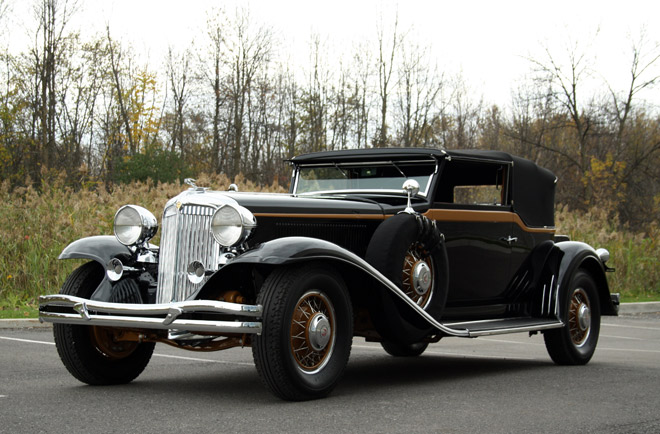SCM Analysis
Detailing
| Vehicle: | 1931 Chrysler CG Imperial convertible Victoria |
This Chrysler CG Imperial Convertible Victoria, Lot 214, sold for $522,500, including buyer’s premium, during RM’s Arizona Biltmore sale on January 20, 2012.
Chrysler introduced the Series CG Imperial in July 1930, and it was a completely different automobile than the company’s previous luxury cars. It carried an 8-cylinder engine, it rolled on a longer, 145-inch wheelbase and the radiator shell had become a grille that was canted back at a rakish angle. The long hood and flowing fenders accentuated the length of the car. The Imperial’s all-new engine was a 384.4-ci straight eight that generated 125 horsepower.
This car is a delightful union of the elegance of the 145-inch wheelbase Chrysler CG Imperial Convertible Victoria and the creative design of the little-known Waterhouse Coachbuilding Company of Webster, MA.
An unlikely start
Four of the most unlikely of partners formed Waterhouse in 1928.
One was a bankrupt taxicab body manufacturer, another a stockbroker who had studied at Harvard, the third an unemployed accountant, and the final member was a body repair foreman working at Cadillac. Two of the group were Charles Waterhouse and his son, L. Osborne Waterhouse, who were descendants of a vehicle body manufacturer and wanted to continue their family tradition.
They were certainly not an overnight success, as they lived in modest rental housing and drove Model A Fords rather than examples of their own work. In fact, one of their first orders was for 200 small wooden boats that, although they were not exactly custom coachbuilding, did generate much-needed cash.
Waterhouse, in time, developed a relationship with DuPont and produced 82 bodies for them between 1929 and 1930, and their designs went on to grace Packard, Lincoln, Marmon, Cadillac and even Rolls-Royce automobiles.
The Great Depression, which started in 1929, was a difficult period for the luxury car market, and many marques and custom coachbuilders shuttered their doors. Waterhouse had built an estimated 296 bodies when, in 1933, they withdrew from coachbuilding to concentrate on making upholstered furniture.
One of three Waterhouse-bodied Imperials
In 1930, Chrysler signed a contract with Waterhouse. In an interview conducted in 1969, Moses Waterhouse stated that 120 custom bodies were delivered to Chrysler. That number is unrealistic, as it exceeds the total Chrysler production released to custom coachbuilders other than LeBaron between 1931 and 1933. Larry Waterhouse, the grandson of the firm’s founder, estimates the number to be 31, with at least three Waterhouse-bodied Chrysler Imperials surviving.
One of the remaining 1931 Chrysler CG Imperial Victorias with a Waterhouse body was offered at RM’s March 13, 2009, Amelia Island sale. It realized $522,500 — as did this car — but it was not finished to the same exacting detail as our subject car.
The Amelia Island car didn’t have interior lights mounted in the rear top bow, the running board material was incorrect, it did not have the distinctive Waterhouse sun visor, and the windshield-wiper motor was mounted incorrectly.
The Chrysler Imperial presented at this sale was a fresh restoration that was finished to exacting detail, with particular attention to authenticity. It was a superior car compared with what was offered three years earlier, but it sold for the same amount.
Auctions can be unpredictable, but it always takes at least two bidders to move a car upward in price. In this case, the buyer was prepared to go to at least $600,000, but his lower bid won the car. The buyer was thrilled, and he feels the car was very well bought. We certainly agree.
